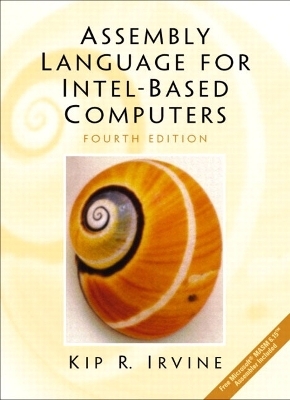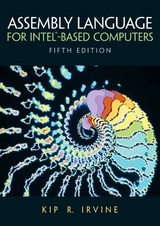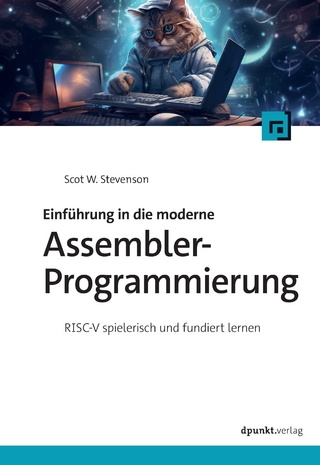
Assembly Language for Intel-Based Computers
Pearson (Verlag)
978-0-13-091013-4 (ISBN)
- Titel erscheint in neuer Auflage
- Artikel merken
For undergraduate courses in assembly language programming and introductory courses in computer systems and computer architecture.
This complete and fully updated study of assembly language for the IBM-PC teaches students how to write and debug programs at the machine level. Based on the Intel processor family, the text simplifies and demystifies concepts that students need to grasp before they can go on to more advanced computer architecture or operating systems courses.
Kip Irvine has written four computer programming textbooks, for Intel Assembly Language, C++, Visual Basic, and COBOL. His Assembly Language for Intel-Based Computers has been translated to six languages, and has been a best seller since 1990. Kip grew up in Hawaii as a surfer, sailor, and surfboard maker. He studied classical guitar and music composition at University of Hawaii, eventually earning his music doctorate from the University of Miami. He began programming computers for music synthesis around 1982, and taught at Miami-Dade Community College. He has a Masters degree in Computer Science from the University of Miami, and is currently on the computer science faculty at Florida International University.
(NOTE: Each chapter section ends with a review and each chapter includes a summary.)
1. Basic Concepts.
Welcome to Assembly Language. Virtual Machine Concept. Data Representation. Boolean Operations.
2. Machine Architecture.
General Concepts. IA-32 Processor Architecture. IA-32 Memory Management. Components of an IA-32 Microcomputer. Input-Output System.
3. Assembly Language Fundamentals.
Basic Elements of Assembly Language. Example: Adding Three Integers. Assembling, Linking, and Running Programs. Defining Data. Symbolic Constants. Real-Address Mode Programming.
4. Data Transfers, Addressing, and Arithmetic.
Data Transfer Instructions. Addition and Subtraction. Data-Related Operators and Directives. Indirect Addressing. JMP and LOOP Instructions.
5. Procedures.
Linking to an External Library. The Book's Link Library. Stack Operations. Defining and Using Procedures. Program Design Using Procedures.
6. Conditional Processing.
Boolean and Comparison Instructions. Conditional Jumps. Conditional Loop Instructions. Conditional Structures. Finite State Machines (Application). Using the .IF Directive.
7. Integer Arithmetic.
Shift and Rotate Instructions. Shift and Rotate Applications. Multiplication and Division Instructions. Extended Addition and Subtraction. ASCII and Packed Decimal Arithmetic (Optional).
8. Advanced Procedures.
Local Variables. Stack Parameters. Stack Frames. Recursion. Creating MultiModule Programs.
9. Strings and Arrays.
String Primitive Instructions. Selected String Routines. Two-Dimensional Arrays. Searching and Sorting Integer Arrays.
10. Structures and Macros.
Structures. Macros. Conditional-Assembly Directives. Defining Repeat Blocks.
11. 32-Bit Windows Programming.
Win32 Console Programming. Writing a Graphical Windows Application. IA-32 Memory Management.
12. High-Level Language Interface.
Introduction. Inline Assembly Code. Linking to C++ Programs.
13. 16-Bit MS-DOS Programming.
MS-DOS and the IBM-PC. MS-DOS Function Calls (INT 21h). Standard MS-DOS File I/O Services.
14. Disk Fundamentals.
Disk Storage Systems. File Systems. Disk Directory. Reading and Writing Disk Sectors. System-Level File Functions.
15. BIOS-Level Programming.
Introduction. BIOS-Level Keyboard Input (INT 16H). Video Programming with INT 10h. Drawing Graphics Using INT 10h. Direct Memory Mapped Graphics. Mouse Programming.
16. Expert MS-DOS Programming.
Introduction. Defining Segments. Runtime Program Structure. Interrupt Handling.
Appendix A: Installing and Using the Assembler.
Installing the book's CD-ROM. Assembling and Linking 32-Bit Protected Mode Programs. Assembling and Linking 16-bit Real-Address Mode Programs.
Appendix B: MASM Reference.
Microsoft Assembler (ML). LINK. CodeView Debugger. MASM Directives. Symbols. Operators. Run-Time Operations.
Appendix C: The Intel Instruction Set.
Appendix D: BIOS and MS-DOS Interrupts.
Overall Interrupt List. Interrupt 21H Functions. Interrupt 10H Functions. Keyboard BIOS INT 16h Functions.
| Erscheint lt. Verlag | 21.8.2002 |
|---|---|
| Sprache | englisch |
| Maße | 186 x 241 mm |
| Gewicht | 1260 g |
| Themenwelt | Informatik ► Programmiersprachen / -werkzeuge ► Assembler |
| ISBN-10 | 0-13-091013-9 / 0130910139 |
| ISBN-13 | 978-0-13-091013-4 / 9780130910134 |
| Zustand | Neuware |
| Informationen gemäß Produktsicherheitsverordnung (GPSR) | |
| Haben Sie eine Frage zum Produkt? |
aus dem Bereich

